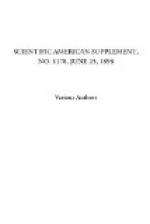In relation to the first, it has been suggested that if consciousness be regarded as dependent upon a certain rate of atomic vibration, it is possible that this rate depends on a store of intramolecular oxygen, which, owing to fatigue, may become exhausted; or it may be supposed that alkaloidal substances may collect as fatigue products within the brain, and choke the activity of that organ. Against this theory may be submitted the facts that monotony of stimulus will produce sleep in an unfatigued person, that over-fatigue, either mental or bodily, will hinder the onset of sleep, that the cessation of external stimuli by itself produces sleep. As an example of this last, may be quoted the case recorded by Strumpel of a patient who was completely anaesthetic save for one eye and one ear, and who fell asleep when these were closed. Moreover, many men possess the power, by an effort of will, of withdrawing from objective or subjective stimuli, and of thus inducing sleep.
The histological theories of sleep are founded on recent extraordinary advances in the knowledge of the minute anatomy of the central nervous system, a knowledge founded on the Golgi and methylene blue methods of staining. It is held possible that the dendrites or branching processes of nerve cells are contractile, and that they, by pulling themselves apart, break the association pathways which are formed by the interlacing or synapses of the dendrites in the brain. Ramon y Cajal, on the other hand, believes that the neuroglia cells are contractile, and may expand so as to interpose their branches as insulating material between the synapses formed by the dendrites of the nerve cells. The difficulty of accepting these theories is that nobody can locate consciousness to any particular group of nerve cells. Moreover, the anatomical evidence of such changes taking place is at present of the flimsiest character.
If these theories be true, what, it may be asked, is the agency that causes the dendrites to contract or the neuroglia cells to expand? Is there really a soul sitting aloof in the pineal gland, as Descartes held? When a man like Lord Brougham can at any moment shut himself away from the outer world and fall asleep, does his soul break the dendritic contacts between cell and cell; and when he awakes, does it make contacts and switch the impulses evoked by sense stimuli on to one or other tract of the axons, or axis cylinder processes, which form the association pathways? Such a hypothesis is no explanation; it simply puts back the whole question a step further, and leaves it wrapped in mystery. It cannot be fatigue that produces the hypothetical interruptions of the dendritic synapses and then induces sleep, for sleep can follow after fatigue of a very limited kind. A man may sleep equally well after a day spent in scientific research as after one spent in mountain climbing, or after another passed in idling by the seashore. He may spend a whole day engaged in mathematical calculation or in painting a landscape. He fatigues—if we admit the localization of function to definite parts of the brain—but one set of association tracts, but one group of cells, and yet, when he falls asleep, consciousness is not partially, but totally suspended.




